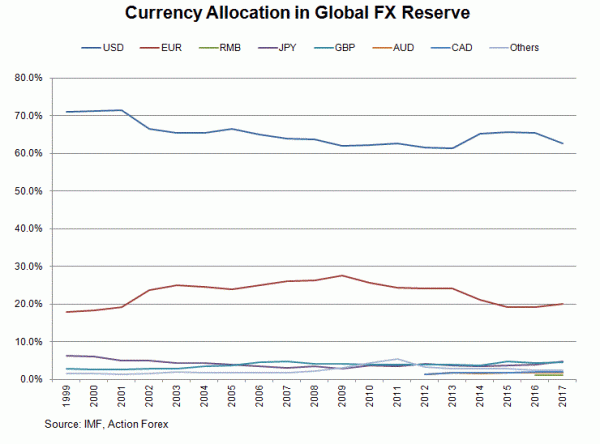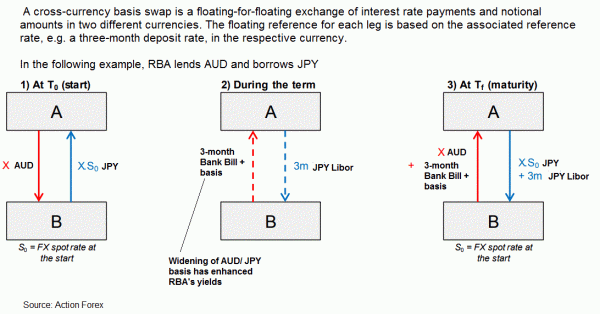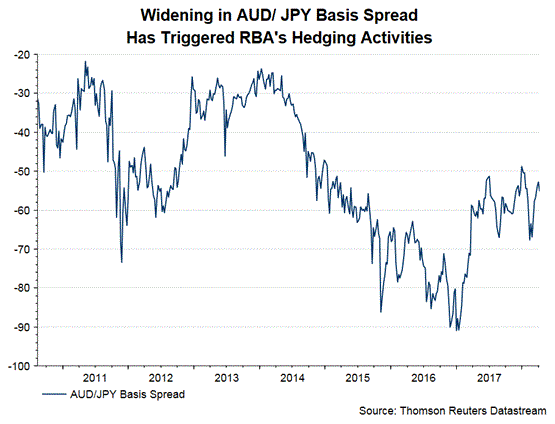In IMF’s latest world FX reserve report*, central bank’s/ reserve managers’ demand for US dollar remained intact in 4Q17. This has not only reinforced the greenback’s dominant status as the world’s reserve currency, but also signaled other currencies still failed to gain widespread confidence due to the economic and/ or financial developments of the corresponding economies. Global central banks’ holdings of US dollar in their FX reserves dropped -0.8 percentage point to 62.7 in 4Q17, from a quarter ago. From a year- over- year basis, the composition fell -2.6 percentage points. From a broader perspective, USD’s share of reserve has fallen from over 70% in the early 21st century to a record low of 61.2% in 2013. The rapid decline after the 2008 Global Financial Crisis was driven by the Fed unprecedented QE program (virtually money printing in nature) which had caused confidence crisis over the credibility of USD. We did see gradual recovery of USD’s share to recent years’ peak of 65.7% in 2015 after the Fed confirmed the end of the 5-year QE program in October 2014. The remarkable 2.6-percentage point decline in USD’s share last year from 2016 mainly represents central banks’ shift in asset holding in order to minimize the impact of USD’s depreciation, instead of an attempt to replace the greenback with other currencies as the main reserve currencies.

The Euro
The distant second and third dominant currencies in global FX reserve are the euro and Japanese yen, respectively. Both were once considered challenging to USD’s status. Consider the euro, its rise in share since inception in 1999 has been at the expense of that of USD, but has never touched 30% so far. Once perceived a challenge to the greenback’s pre-eminence, confidence over the single currency has deteriorated after the European sovereign debt crisis. Although recent economic and financial indicators in the Eurozone as a whole suggest that the worst is behind us, a number of peripheral economies have continued to struggle with high deficit- to- GDP ratios and high unemployment. Reserve managers should remain vigilant when accumulating the euro.
Japanese Yen
Despite its exceptionally low interest rates and the lukewarm growth in the economy, Japanese yen’s share has increased for three consecutive years, from 3.5% in 2014 to 4.9% in 2017. We attribute this phenomenon to the hedging activities as the “cross currency basis” between Japanese yen and many other currencies has been wide. Indeed, RBA’s annual report (https://www.rba.gov.au/publications/annual-reports/rba/2017/) has revealed this. While JPY-denominated assets took up 67% of RBA’s FX reserve in 1H17, the contribution was greatly reduced to 4.8% after “forward FX commitments”- a FX swap operation undertaken by RBA so as to enhance returns on the portfolio- were adjusted. As suggested in the report, over the past several years, “when the cost of hedging currency risk is taken into account, yields on short-dated Japanese investments have generally exceeded those available in the other currencies in the Reserve Bank’s portfolio”. As a result, “the bulk of the foreign currency the Bank obtains from swaps against Australian dollars is Japanese yen”. Moreover, Bradley Jones, Head of RBA’s International Department, noted two weeks ago that “by leaning into a widening basis, reserve managers stand to both harvest additional yield in reserve currencies, and play a constructive role in rebalancing the market, thus encouraging the prudent hedging of cross-border capital flows”. This evidenced that the rising allocation in Japanese yen in global FX reserve has probably be driven by hedging activities, rather than the increase in confidence over the currency.


As US-China trade frictions intensify, one of the “predictions” is that China is going dump US government bonds as retaliation to the White House’ s tariffs. As the biggest foreign holder of US Treasuries, it appears that the move would be disastrous for the US during the time when the country is in need to finance its federal deficits. However, we regard this as a bargaining chip in the upcoming trade negotiation. Indeed, the latest data (http://ticdata.treasury.gov/Publish/mfh.txt) shows that that China has held US$1.17 trillion worth of Us Treasury securities as of January 2018. Despite dropping -1.4% from the prior month, holding marks a +11.1% from the same period last year. As the biggest exporter to the US, China has earned a massive and lucrative amount of foreign currency in USD. The most secure and convenient channel to invest the money is via Treasury securities. As such, the act of dumping US Treasuries is no less than shooting itself in the foot.
*Currency Composition of Official Foreign Exchange Reserves (COFER): http://www.imf.org/en/News/Articles/2017/03/31/pr17108-IMF-Releases-Data-on-the-Currency-Composition-of-Foreign-Exchange-Reserves













